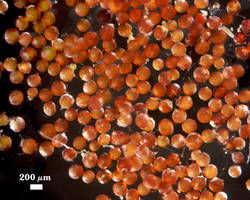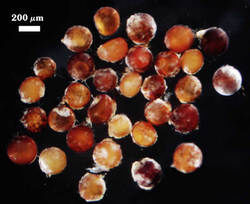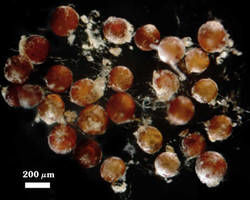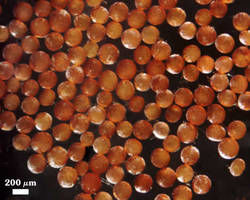Dentiscutata heterogama
Preparing clean healthy spores for shipment
Extracted spores

Fungal species with darkly pigmented and ornamented spores are amongst the most difficult to clean up because there is not dramatic contrast between healthy spores and those in various stages of degradation. Dentiscutata heterogama is an excellent example of what to expect. In the photo at left, almost 30% of the spores exhibit some departure from the typical healthy spore and must be removed, but they are hard to spot. The surface spines covering the spore wall surface attract a coating of organic material that is whitish under reflected light and is present on many spores.
The Problem with Roots

Once spores are extracted, they should be immediately separated from any root fragments carried along in the sieving process. Otherwise, hyphae often begin to grow from root fragments and bind spores with debris within 12 hours. This behavior is more prevalent for cultures stored for 6 months or longer. In the photo above spores aggregate from hyphae of fungal saprophytes and that of D. heterogama.

Spores with patchy contents
For darkly pigmented spores, we rely on signs of disruption in cellular contents. Spores with any compartmentalization of lipids, patchiness, milky appearance, etc. are deemed unhealthy and removed. When otherwise healthy-appearing spores express any of these phenotypes after another 24 hr incubation, they also are removed.
Parasitized spores

The most common parasites of spores are saprophytic fungi and some actinomycetes. In addition to changes in spore contents, signs of hyphae growing out of parasitized spores become apparent after 24-48 hr of refrigeration. If hyphal growth is not evident but spores still clump together, then all of these spores are removed as well.

Healthy spores will have undergone little change after at least 24 hr incubation in a refrigerator and are considered ready for shipment in sterile sand or distilled water. Again, it is important to note that with ornamented spores, such as those of D. heterogama, the white coating on spore surfaces is normal. Notice that the spores in this photo have relatively uniform lipid globules. Any deviation from this, even if spores otherwise appear healthy, warrants removal.